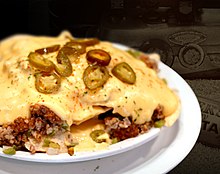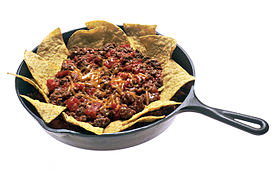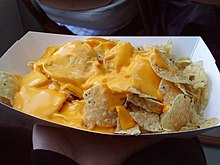Nachos: Difference between revisions
m Reverted 1 edit by 207.32.32.2 identified as vandalism to last revision by Philip Trueman. (TW) |
|||
| Line 96: | Line 96: | ||
| publisher = Taco Bell Corporation |
| publisher = Taco Bell Corporation |
||
| url = http://www.tacobell.com/ |
| url = http://www.tacobell.com/ |
||
| accessdate = 2008-12-30}}</ref> Unlike [[Protected Geographical Status|many European cheeses]], "nacho cheese" bears no [[geographical indication]] or other regulated guarantee of ingredients, process, or quality, beyond the general [[Cheese_product#Legal_issues|legal definition for cheese products]] as established by the U.S. [[Food & Drug Administration]]. |
| accessdate = 2008-12-30}}</ref> Unlike [[Protected Geographical Status|many European cheeses]], "nacho cheese" bears no [[geographical indication]] or other regulated guarantee of ingredients, process, or quality, beyond the general [[Cheese_product#Legal_issues|legal definition for cheese products]] as established by the U.S. [[Food & Drug Administration]]. nakia brown has big balls |
||
==See also== |
==See also== |
||
Revision as of 16:20, 7 October 2010

Nachos are a popular corn based food of Mexican origin associated with Tex-Mex cuisine that can be either made fast to serve as a snack or prepared with more ingredients to make a full meal. In their simplest form, nachos are tortilla chips or totopos covered in melted cheese. First created circa 1943 by Ignacio "Nacho" Anaya, the original nachos consisted of fried corn tortillas covered with melted cheddar cheese and pickled jalapeño peppers.
History
Nachos originated in the city of Piedras Negras, Coahuila, Mexico, just over the border from Eagle Pass, Texas, at a restaurant called the Victory Club, owned by Rodolfo De Los Santos.[1][2] One day in 1943, the wives of ten to twelve U.S. soldiers stationed at Fort Duncan in nearby Eagle Pass were in Piedras Negras on a shopping trip, and arrived at the restaurant after it had closed for the day. The maître d', Ignacio "Nacho" Anaya, invented a new snack for them with what little he had available in the kitchen: tortillas and cheese. Anaya cut the tortillas into triangles, added longhorn cheddar cheese, quickly heated them, and added sliced jalapeño peppers.[Note 1] He served the dish, calling it Nacho's especiales[3] - meaning something like "Nacho's special dish" in Spanish.
Anaya went on to work at the Moderno Restaurant in Piedras Negras, which still uses the original recipe. He also opened his own restaurant, "Nacho's Restaurant", in Piedras Negras. Anaya's original recipe was printed in the 1954 St. Anne's Cookbook.[1][2]
The popularity of the dish swiftly spread throughout Texas. The first known appearance of the word "nachos" in English dates to 1949, from the book A Taste of Texas.[1] Waitress Carmen Rocha is credited with introducing the dish to Los Angeles at El Cholo Mexican restaurant in 1959.[4]

A modified version of the dish, with permanently soft cheese and pre-made tortilla chips was marketed by a man named Frank Liberto beginning in 1977, during sporting events at Arlington Stadium in Arlington, Texas this version of nachos became known as "Ball Park Nachos". During a Monday Night Football game, sportscaster Howard Cosell enjoyed the name "nachos", and made a point of mentioning the dish in his broadcasts over the following weeks, further popularizing it and introducing it to a whole new audience.[5][6][7]
Ignacio Anaya died in 1975. In his honor, a bronze plaque was erected in Piedras Negras, and October 21 was declared the International Day of the Nacho. Anaya's son Ignacio Anaya Jr. serves as a judge at the annual nacho competition.[1][2]
Variations
A variation consists of a quartered and fried tostada topped with a layer of refried beans and/or various meats and a layer of shredded cheese.

Common additional toppings include:
- Ground beef, chicken, carne asada,
- Chili con carne
- Jalapeño or other capsicum peppers or red peppers
- Onions
- Salsa
- Elote
- Guacamole
- Sour cream
- Lettuce
- Tomatoes
- Olives
- Refried beans
- Pinto beans
- Black beans
- Pico de Gallo
- Cilantro
- Lime
- Pickles
Nachos with an abundance of toppings are sometimes called "loaded nachos" or "super nachos". This type of dish is usually served as an appetizer at bars or restaurants in the United States and generally tend to be as sizable as a meal. The dish is normally prepared in this manner: The tortilla chips are arranged on a platter, meat and refried bean toppings are then added, and the entire platter is smothered with shredded cheese. The platter is then put into a broiler or microwave to allow the cheese to melt. The platter is then covered with the cold toppings (shredded lettuce, tomatoes, salsa, jalapeños, etc.) and served immediately.
In Memphis, Tennessee, barbecue nachos are served in most barbecue restaurants, and also at sporting events. Generous portions of barbecued pork shoulder are placed atop tortilla chips, then covered with melted cheese, barbecue sauce, and sliced jalapeño peppers.
A similar dish that involves tortilla chips and cheese is found in Tex-Mex restaurants. Small bowls of chili con queso and/or, more commonly, salsa, are served with baskets of warm tortilla chips as appetizers.

Nacho cheese
A form of processed cheese mixed with peppers and other spices is often used in place of freshly shredded cheese in institutional or large-scale production settings, such as schools, movie theaters, sports venues, and convenience stores, or wherever using freshly grated cheese may be logistically prohibitive. Such processed cheese is referred to in the United States as "nacho cheese", and alternatively "queso cheese" (or just "queso"). Though originally formulated as a cheaper and more convenient source of cheese to top nachos, this dip has become popular enough in the U.S. that it is available in some Mexican-themed restaurants, and at major grocery stores, in both name-brand (Frito-Lay, Tostitos, and Taco Bell) and off-brand versions.[8] Unlike many European cheeses, "nacho cheese" bears no geographical indication or other regulated guarantee of ingredients, process, or quality, beyond the general legal definition for cheese products as established by the U.S. Food & Drug Administration. nakia brown has big balls
See also
Notes
- 1.^ Anaya's son, Ignacio Anaya, Jr., is quoted as saying "My father was maître d' and he said 'Let me go quick and fix something for you.' He went into the kitchen, picked up tostados,' grated some cheese on them—Wisconsin cheese, the round one—and put them under the Salamander (a broiling unit that browns the top of foods). He pulled them out after a couple minutes, all melted, and put on a slice of jalapeño."[2]
References
- ^ a b c d Orr, Adriana P. (1999). "Nachos, anyone?". OED News. Oxford University Press. Retrieved 2007-11-04.
{{cite web}}: Unknown parameter|month=ignored (help) - ^ a b c d Haram, Karen. "The History of the Nacho". San Antonio Express-News.
- ^ "Nachos 101". Homesick Texan. January 29, 2008. Retrieved 2009-01-07.
- ^ "Waitress Who Introduced L.A. To Nachos Dies". Morning Edition. October 17, 2008. National Public Radio.
{{cite episode}}: Cite has empty unknown parameter:|episodelink=(help); External link in|title=and|transcripturl=|serieslink=ignored (|series-link=suggested) (help); Unknown parameter|transcripturl=ignored (|transcript-url=suggested) (help) - ^ Munsey; Suppes. "Arlington Stadium". Ballparks.com. Retrieved 2008-12-30.
- ^ "History". Originators of Concession Nachos. Ricos Products Co., Inc. Retrieved 2008-12-30.
- ^ Sokolov, Raymond (2006-02-06). "The Search for the Perfect Nacho". Wall Street Journal. Retrieved 2008-06-27.
- ^ "Our Food: The Menu: Nachos & Sides". Tacobell.com. Taco Bell Corporation. Retrieved 2008-12-30.
- Dunne, Mike. (January 28, 2004). "One spicy tale: 'Macho Nachos'". Sacramento Bee, p. F1.
